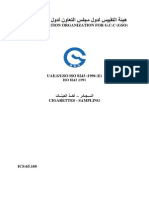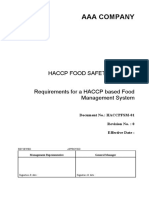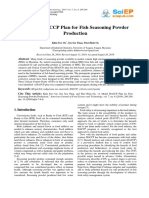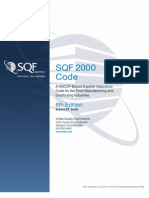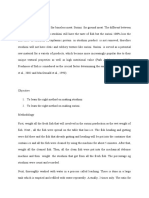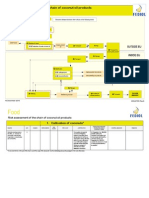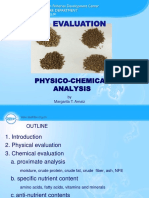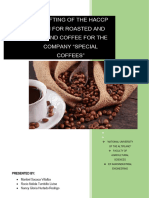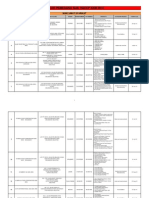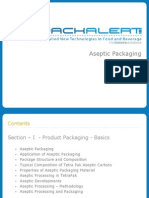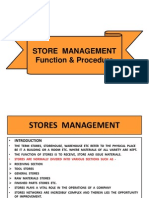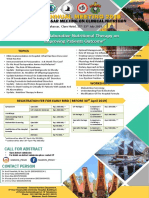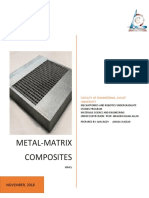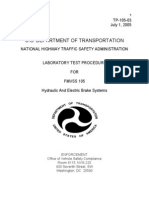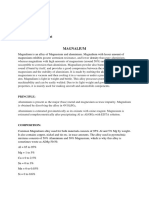Codex General Standard For Cheese
Codex General Standard For Cheese
Uploaded by
sunil2700Copyright:
Available Formats
Codex General Standard For Cheese
Codex General Standard For Cheese
Uploaded by
sunil2700Original Title
Copyright
Available Formats
Share this document
Did you find this document useful?
Is this content inappropriate?
Copyright:
Available Formats
Codex General Standard For Cheese
Codex General Standard For Cheese
Uploaded by
sunil2700Copyright:
Available Formats
1
Codex Standard 283-1978
CODEX GENERAL STANDARD FOR CHEESE
CODEX STAN 283-1978 1. SCOPE
This Standard applies to all products, intended for direct consumption or further processing, in conformity with the definition of cheese in Section 2 of this Standard. Subject to the provisions of this Standard, standards for individual varieties of cheese, or groups of varieties of cheese, may contain provisions which are more specific than those in this Standard and in these cases, those specific provisions shall apply.
2.
2.1
DESCRIPTION
Cheese is the ripened or unripened soft, semi-hard, hard, or extra-hard product, which may be coated, and in which the whey protein/casein ratio does not exceed that of milk, obtained by: (a) coagulating wholly or partly the protein of milk, skimmed milk, partly skimmed milk, cream, whey cream or buttermilk, or any combination of these materials, through the action of rennet or other suitable coagulating agents, and by partially draining the whey resulting from the coagulation, while respecting the principle that cheese-making results in a concentration of milk protein (in particular, the casein portion), and that consequently, the protein content of the cheese will be distinctly higher than the protein level of the blend of the above milk materials from which the cheese was made; and/or (b) processing techniques involving coagulation of the protein of milk and/or products obtained from milk which give an end-product with similar physical, chemical and organoleptic characteristics as the product defined under (a). Ripened cheese is cheese which is not ready for consumption shortly after manufacture but which must be held for such time, at such temperature, and under such other conditions as will result in the necessary biochemical and physical changes characterizing the cheese in question. Mould ripened cheese is a ripened cheese in which the ripening has been accomplished primarily by the development of characteristic mould growth throughout the interior and/or on the surface of the cheese. Unripened cheese including fresh cheese is cheese which is ready for consumption shortly after manufacture.
2.1.1
2.1.2
2.1.3
3.
3.1
ESSENTIAL COMPOSITION AND QUALITY FACTORS
Raw materials
Milk and/or products obtained from milk.
3.2
Permitted ingredients
4.
Starter cultures of harmless lactic acid and/or flavour producing bacteria and cultures of other harmless microorganisms Safe and suitable enzymes Sodium chloride Potable water
FOOD ADDITIVES
Only those food additives listed below may be used and only within the limits specified.
Unripened cheeses
As listed in the Standard for Unripened Cheese Including Fresh Cheese (CODEX STAN 221-2001).
Cheeses in brine
As listed in the Standard for Cheeses in Brine (CODEX STAN 208-1999).
Ripened cheeses, including mould ripened cheeses
Additives not listed below but provided for in Codex individual standards for varieties of ripened cheeses may also be used for similar types of cheese within the limits specified within those standards.
Formerly CODEX STAN A-6-1973. Adopted in 1973. Revision 1999, Amendments 2006, 2008, 2010, 2013.
Codex Standard 283-1978
INS no.
Colours 100 101 120 140 141 160a(i) 160a(ii) 160b(ii)
Name of additive
Maximum level
Curcumins (for edible cheese rind) Riboflavins Carmines (for red marbled cheeses only) Chlorophyll (for green marbled cheeses only) Chlorophylls, copper complexes Carotene, beta-, synthetic Carotenes, beta-, vegetable Annatto extracts, norbixin based
Limited by GMP Limited by GMP Limited by GMP Limited by GMP 15 mg/kg 25mg/kg 600 mg/kg 50 mg/kg
160c 160e 160f 162 171 Acidity regulators 170 504 575 Preservatives 200 201 202 203 234 239 251 252 280 281 282 1105
Paprika oleoresin Carotenal, beta-apo-8Carotenoic acid, ethyl ester, beta-apo-8Beet red Titanium dioxide
Limited by GMP 35 mg/kg 35 mg/kg Limited by GMP Limited by GMP
Calcium carbonates Magnesium carbonates Glucono delta-lactone Limited by GMP
Sorbic acid Sodium sorbate 3 000 mg/kg calculated as sorbic acid Potassium sorbate Calcium sorbate Nisin Hexamethylene tetramine (Provolone only) Sodium nitrate 50 mg/kg, expressed as NaNO3 Potassium nitrate Propionic acid Sodium propionate Calcium propionate Lysozyme Limited by GMP 3 000 mg/kg, calculated as propionic acid 12.5 mg/kg 25 mg/kg, expressed as formaldehyde
For surface/rind treatment only: 200 202 203 235 Sorbic acid Potassium sorbate Calcium sorbate Natamycin (pimaricin) 2 mg/dm2 of surface. Not present in a depth of 5 mm 1 000 mg/kg singly or in combination, calculated as sorbic acid
Miscellaneous additive 508 Potassium chloride Limited by GMP
Anti-caking agents (Sliced, cut, shredded or grated cheese) 460 551 552 553 560 Celluloses Silicon dioxide, amorphous Calcium silicate Magnesium silicates Potassium silicate 10 000 mg/kg singly or in combination. Silicates calculated as silicon dioxide Limited by GMP
Codex Standard 283-1978
INS no.
Preservatives 200 202 203
Name of additive
Maximum level
Sorbic acid Potassium sorbate Calcium sorbate 1 000 mg/kg singly or in combination, calculated as sorbic acid
5.
CONTAMINANTS
The products covered by this Standard shall comply with the Maximum Levels for contaminants that are specified for the product in the General Standard for Contaminants and Toxins in Food and Feed (CODEX STAN 193-1995). The milk used in the manufacture of the products covered by this Standard shall comply with the Maximum Levels for contaminants and toxins specified for milk by the General Standard for Contaminants and Toxins in Food and Feed (CODEX STAN 193-1995) and with the maximum residue limits for veterinary drug residues and pesticides established for milk by the CAC.
6.
HYGIENE
It is recommended that the products covered by the provisions of this standard be prepared and handled in accordance with the appropriate sections of the General Principles of Food Hygiene (CAC/RCP 1-1969), the Code of Hygienic Practice for Milk and Milk Products (CAC/RCP 57-2004) and other relevant Codex texts such as Codes of Hygienic Practice and Codes of Practice. The products should comply with any microbiological criteria established in accordance with the Principles and Guidelines for the Establishment and Application of Microbiological Criteria Related to Foods (CAC/GL 21-1997).
7.
LABELLING
In addition to the provisions of the General Standard for the Labelling of Prepackaged Foods (CODEX STAN 1-1985) and the General Standard for the Use of Dairy Terms (CODEX STAN 206-1999), the following specific provisions apply:
7.1
Name of the food
The name of the food shall be cheese. However, the word cheese may be omitted in the designation of an individual cheese variety reserved by a Codex standard for individual cheeses, and, in the absence thereof, a variety name specified in the national legislation of the country in which the product is sold, provided that the omission does not create an erroneous impression regarding the character of the food.
7.1.1
In case the product is not designated with a variety name but with the designation cheese alone, the designation may be accompanied by the appropriate descriptive terms in the following table:
DESIGNATION ACCORDING TO FIRMNESS AND RIPENING CHARACTERISTICS According to firmness: Term 1 MFFB%
< 51 4956 5469 > 67
Designation
Extra hard Hard Firm/Semi-hard Soft
According to principal ripening: Term 2
Ripened Mould ripened Unripened/Fresh In Brine
Codex Standard 283-1978
MFFB equals percentage moisture on a fat-free basis, i.e., Weight of moisture in the cheese Total weight of cheese Weight of fat in the cheese
100
Example: The designation of a cheese with moisture on a fat-free basis of 57% which is ripened in a manner similar in which Danablu is ripened would be: Mould ripened firm cheese or firm mould ripened cheese.
7.2
Declaration of milkfat content
The milkfat content shall be declared in a manner found acceptable in the country of sale to the final consumer, either (i) as a percentage by mass, (ii) as a percentage of fat in dry matter, or (iii) in grams per serving as quantified in the label provided that the number of servings is stated. Additionally, the following terms may be used: High fat Full fat Medium fat Partially skimmed Skim (if the content of FDM is above or equal to 60%); (if the content of FDM is above or equal to 45% and less than 60%) (if the content of FDM is above or equal to 25% and less than 45%) (if the content of FDM is above or equal to 10% and less than 25%) (if the content of FDM is less than 10%)
7.3
Date marking
Notwithstanding the provisions of Section 4.7.1 of the General Standard for the Labelling of Prepackaged Foods (CODEX STAN 1-1985), the date of minimum durability need not be declared in the labelling of firm, hard and extra hard cheese which are not mould/soft-ripened and not intended to be purchased as such by the final consumer: in such cases the date of manufacture shall be declared.
7.4
Labelling of non-retail containers
Information required in Section 7 of this Standard and Sections 4.1 to 4.8 of the General Standard for the Labelling of Prepackaged Foods (CODEX STAN 1-1985), and, if necessary, storage instructions, shall be given either on the container or in accompanying documents, except that the name of the product, lot identification, and the name and address of the manufacturer or packer shall appear on the container, and in the absence of such a container on the cheese itself. However, lot identification, and the name and address of the manufacturer or packer may be replaced by an identification mark, provided that such a mark is clearly identifiable with the accompanying documents.
8.
METHODS OF SAMPLING AND ANALYSIS
See CODEX STAN 234-1999.
APPENDIX
APPENDIX
1
CHEESE RIND
During ripening of the moulded cheese curd in natural creation or in environments in which the air humidity and, possibly, air composition are controlled, the outside of the cheese will develop into a semi-closed layer with a lower moisture content. This part of the cheese is called rind. The rind is constituted of cheese mass which, at the start of the ripening, is of the same composition as the internal part of the cheese. In may cases, the brining of cheese initiates the formation of rind. Due to the influence of the salt gradient in the brine, of oxygen, of drying out and of other reactions, the rind successively becomes of a somewhat different composition than the interior of the cheese and often presents a more bitter taste.
Amendment adopted by the 26th Session of the Codex Alimentarius Commission (2003).
Codex Standard 283-1978
During or after ripening the cheese rind can be treated or can be naturally colonized with desired cultures of microorganisms, for instance Penicillium candidum or Brevibacterium linens. The resulting layer, in some cases referred to as smear, forms a part of the rind. Rindless cheese is ripened by the use of a ripening film. The outer part of that cheese does not develop a rind with a lower moisture content although influence of light of course can cause some difference compared to the inner part.
CHEESE SURFACE
The term cheese surface is used for the outside layer of cheese or parts of cheese, even in the sliced, shredded or grated form. The term includes the outside of the whole cheese, disregarding whether a rind has been formed or not.
CHEESE COATINGS
Cheese can be coated prior to the ripening, during the ripening process or when the ripening has been finished. When a coating is used during ripening the purpose of the coating is to regulate the moisture content of the cheese and to protect the cheese against micro-organisms. Coating of a cheese after the ripening has been finished is done to protect the cheese against microorganisms and other contamination, to protect the cheese from physical damage during transport and distribution and/or to give the cheese a specific appearance (e.g. coloured). Coating can be distinguished very easily from rind, as coatings are made of non-cheese material, and very often it is possible to remove the coating again by brushing, rubbing or peeling it off. Cheese can be coated with: A film, very often polyvinylacetate, but also other artificial material or material composed of natural ingredients, which helps to regulate the humidity during ripening and protects the cheese against microorganisms (for example, ripening films).2 A layer, mostly wax, paraffin or a plastic, which normally is impermeable to moisture, to protect the cheese after ripening against microorganisms and against physical damage during retail handling and, in some cases to contribute to the presentation of the cheese.
Wheat gluten or wheat protein products should not be used for technological reasons e.g. coating or processing aids for foods which are gluten-free by nature Standard for Wheat Protein Products including Wheat Gluten (CODEX STAN 163-1987).
You might also like
- Avance - CS2 - (MANUAL DE SERVICIO)Document486 pagesAvance - CS2 - (MANUAL DE SERVICIO)Ignacio Nicolas100% (15)
- Additives Use Food Stuffs enDocument637 pagesAdditives Use Food Stuffs enfajarNo ratings yet
- Bendi AC PM F-523-R4 PDFDocument128 pagesBendi AC PM F-523-R4 PDFMonserrat Hernández SánchezNo ratings yet
- Cxs 152e CodexDocument3 pagesCxs 152e CodexGisela Prima PaskhalienNo ratings yet
- Frying Pressure and Temperature Effects On Sensory Characteristics of Coated Chicken NuggetsDocument5 pagesFrying Pressure and Temperature Effects On Sensory Characteristics of Coated Chicken Nuggetsmonica_bee_1No ratings yet
- GSO-1816-2007-ground MeatDocument9 pagesGSO-1816-2007-ground MeatMohammad Mursalin100% (1)
- Synopsis For Architectural Thesis Project - Healthcare DesignDocument4 pagesSynopsis For Architectural Thesis Project - Healthcare DesignPrathamesh Mamidwar70% (10)
- Ehlers-Danlos Syndrome: A Multidisciplinary ApproachDocument370 pagesEhlers-Danlos Syndrome: A Multidisciplinary ApproachBibis Ginger100% (4)
- PDF Gso 1016 2015 - CompressDocument26 pagesPDF Gso 1016 2015 - CompressadamNo ratings yet
- Gso Iso 8243 1995 eDocument19 pagesGso Iso 8243 1995 eMuhammad Masood AbbasNo ratings yet
- Manual HACCP Food SafetyDocument13 pagesManual HACCP Food SafetyDiane Angelique ArceoNo ratings yet
- Feed Quality Schemes and RegulationDocument46 pagesFeed Quality Schemes and RegulationChukwuemeka Victor100% (1)
- Haccp Matrix Fish SeasoningDocument5 pagesHaccp Matrix Fish SeasoningRindu KinantiNo ratings yet
- POPO FISH MURUKU PRODUCT ANALYSIS TDocument18 pagesPOPO FISH MURUKU PRODUCT ANALYSIS TClarissha0% (1)
- Khoa Based SweetsDocument17 pagesKhoa Based SweetsRonak RawatNo ratings yet
- GB4789. 3 2010 Food Microbiological Examination Enumeration of ColiformsDocument10 pagesGB4789. 3 2010 Food Microbiological Examination Enumeration of ColiformstaufikNo ratings yet
- Biolife - Bacillus Cereus Selective Agar Base - Myp - Ts-5111112Document3 pagesBiolife - Bacillus Cereus Selective Agar Base - Myp - Ts-5111112phonglinh0101No ratings yet
- Advancement in Traditional Heat Desiccated Dairy ProductDocument32 pagesAdvancement in Traditional Heat Desiccated Dairy Productaparnna vpNo ratings yet
- GCC Standardization Organization (Gso)Document13 pagesGCC Standardization Organization (Gso)mdkadryNo ratings yet
- PS-3733-2019 Part 4 PoultryDocument23 pagesPS-3733-2019 Part 4 Poultrymiz baig100% (2)
- Prof Dedi - PMR Untuk Aseptic ProcessingDocument50 pagesProf Dedi - PMR Untuk Aseptic ProcessingBlasius Aditya Putra PermanaNo ratings yet
- Wheat QC Training GuidelineDocument53 pagesWheat QC Training GuidelineMelikteNo ratings yet
- Halal Certification of Insect-Based Food A CritiqueDocument13 pagesHalal Certification of Insect-Based Food A CritiqueAhmadNo ratings yet
- IPSF SPSS Abstracts 2021Document68 pagesIPSF SPSS Abstracts 2021Antoniel Franco100% (1)
- Confectionery and Chocolate ProductsDocument23 pagesConfectionery and Chocolate ProductsPamilaNo ratings yet
- Republic Act 1556Document8 pagesRepublic Act 1556melNo ratings yet
- 2073 2005 For Manufacturers FINALDocument6 pages2073 2005 For Manufacturers FINALjercherwinNo ratings yet
- As 4709-2001 Guide To Cleaning and Sanitizing of Plant and Equipment in The Food IndustryDocument7 pagesAs 4709-2001 Guide To Cleaning and Sanitizing of Plant and Equipment in The Food IndustrySAI Global - APAC0% (1)
- Determination of Total Fat and Free Fat ContentDocument13 pagesDetermination of Total Fat and Free Fat ContentCesar Augusto Torres LinaresNo ratings yet
- Meat Quality IndicatorsDocument8 pagesMeat Quality IndicatorsmujiNo ratings yet
- Pakistan Standard Specification For Wafer BiscuitsDocument7 pagesPakistan Standard Specification For Wafer BiscuitssamanNo ratings yet
- SQF-2000-Code For HACCP ImplementationDocument80 pagesSQF-2000-Code For HACCP ImplementationFlorence Reid100% (1)
- Food and Agricultural Import Regulations and Standards - Narrative - Beijing - China - Peoples Republic of - 12!12!2013Document63 pagesFood and Agricultural Import Regulations and Standards - Narrative - Beijing - China - Peoples Republic of - 12!12!2013Nguyen Thanh TrungNo ratings yet
- Sannan Haider Khan 2020-AG-477 Sara Hassan 2020-AG-GROUP# 19Document22 pagesSannan Haider Khan 2020-AG-477 Sara Hassan 2020-AG-GROUP# 19Sannan Haider KhanNo ratings yet
- Chemical Safety of Meat and Meat Products PDFDocument11 pagesChemical Safety of Meat and Meat Products PDFekosaputrobbppbatuNo ratings yet
- NDDB Standard Operating Procedure: Milk Collection Centre (DCS/MPI) With Testing Facilities 11 January 2016Document6 pagesNDDB Standard Operating Procedure: Milk Collection Centre (DCS/MPI) With Testing Facilities 11 January 2016Kim KimNo ratings yet
- Philippine National Philippine National Philippine National Philippine National Standard Standard Standard StandardDocument19 pagesPhilippine National Philippine National Philippine National Philippine National Standard Standard Standard StandardAngelica DuevoNo ratings yet
- Optimizing Feed Milling Processes For Enhanced Efficiency and QualityDocument26 pagesOptimizing Feed Milling Processes For Enhanced Efficiency and QualityAbu RayhanNo ratings yet
- April 2023 E BookDocument18 pagesApril 2023 E BookkkNo ratings yet
- BAM Chapter 18 - Yeasts, Molds and Mycotoxins - FDADocument13 pagesBAM Chapter 18 - Yeasts, Molds and Mycotoxins - FDAsunnysatwNo ratings yet
- Gso 1931 e Ds 2008Document12 pagesGso 1931 e Ds 2008Joshua AshleyNo ratings yet
- Milk Quality Control: Technical Bulletin No. 2Document15 pagesMilk Quality Control: Technical Bulletin No. 2MD AqeelmusttaffaNo ratings yet
- Gso 05/DS/ Gso: 2022Document12 pagesGso 05/DS/ Gso: 2022Naveed Noor MemonNo ratings yet
- MethodologyDocument7 pagesMethodologyMuhamad Solleh Majid0% (1)
- Dairy Packaging Final 1 1Document33 pagesDairy Packaging Final 1 1Avishka Divyanjali100% (1)
- Cereals: - : IntroductionDocument8 pagesCereals: - : IntroductionAmit Kr Godara100% (1)
- AbattoirsPlantConstructEquipOperation PDFDocument15 pagesAbattoirsPlantConstructEquipOperation PDFAnonymous 49VJOeViANo ratings yet
- Flowchart-Production Chain of CNO (FEDIOL)Document17 pagesFlowchart-Production Chain of CNO (FEDIOL)Lim Chee SiangNo ratings yet
- Nisin in Processed CheeseDocument10 pagesNisin in Processed CheeseSulaeman HidayatNo ratings yet
- Manual of Methods OF Analysis of Foods: Cereal and Cereal ProductsDocument70 pagesManual of Methods OF Analysis of Foods: Cereal and Cereal ProductsRajam SankarNo ratings yet
- Physico-Chemical Evaluation of FeedsDocument29 pagesPhysico-Chemical Evaluation of FeedsGail AidNo ratings yet
- Guidance Document Sixth Edition Version 6.1 PDFDocument130 pagesGuidance Document Sixth Edition Version 6.1 PDFJobanny AlvaradoNo ratings yet
- Haccp Almost Fixed 1Document23 pagesHaccp Almost Fixed 1ScribdTranslationsNo ratings yet
- Halal Critical Point of Microbial Bioprocess BasedDocument8 pagesHalal Critical Point of Microbial Bioprocess Basedcuma72536No ratings yet
- Rekod Pemegang Sijil Haccp 07042014Document54 pagesRekod Pemegang Sijil Haccp 07042014ShinLang ShinBoo100% (1)
- Dairy IndustryDocument30 pagesDairy IndustryHamza KhanNo ratings yet
- Indian Dairy IndustryDocument39 pagesIndian Dairy IndustryAmrish GargNo ratings yet
- Composition of Milk: AcknowledgementDocument23 pagesComposition of Milk: AcknowledgementShallu SharmaNo ratings yet
- Milk HaccpDocument3 pagesMilk HaccpAndre van JaarsveldtNo ratings yet
- Gluten Free Bread Making Trials From Cassava Manihot Esculenta Crantz Flour and Sensory Evaluation of The Final ProductDocument13 pagesGluten Free Bread Making Trials From Cassava Manihot Esculenta Crantz Flour and Sensory Evaluation of The Final ProductVirda Ayu Nia SaputriNo ratings yet
- Cleaning and disinfection of food factories: a practical guideFrom EverandCleaning and disinfection of food factories: a practical guideNo ratings yet
- Aseptic PackagingDocument54 pagesAseptic Packagingsunil2700No ratings yet
- Honey Quality & Intl Regu - StandardsDocument12 pagesHoney Quality & Intl Regu - Standardssunil2700No ratings yet
- Fecal ColiformDocument8 pagesFecal Coliformsunil2700No ratings yet
- Stores ManagementDocument48 pagesStores Managementsunil2700100% (4)
- AOAC EPA RegulationsDocument2 pagesAOAC EPA Regulationssunil2700No ratings yet
- Wounds by Shotguns: by Dilnaaz Baig Roll No-8 Batch 2015 Ii MbbsDocument13 pagesWounds by Shotguns: by Dilnaaz Baig Roll No-8 Batch 2015 Ii Mbbsniraj_sdNo ratings yet
- Open Call The Consulting Room of The Future - Erasmus MCDocument5 pagesOpen Call The Consulting Room of The Future - Erasmus MCnikitaaroranidNo ratings yet
- Smartgoalsws NNDocument1 pageSmartgoalsws NNapi-569332192No ratings yet
- Building Permit Requirement Checklist Pursuant To P.D. 1096, National Building Code of The Philippines and Its IRRDocument1 pageBuilding Permit Requirement Checklist Pursuant To P.D. 1096, National Building Code of The Philippines and Its IRRMei-Ann Cayabyab-PatanoNo ratings yet
- Soal Ujian Bing 6 24Document7 pagesSoal Ujian Bing 6 24MufidahNo ratings yet
- Smoke & MirrorsDocument3 pagesSmoke & MirrorsDavi SantosNo ratings yet
- Mamcn Poster LastDocument1 pageMamcn Poster LastmichelNo ratings yet
- Metal Matrix CompositesDocument20 pagesMetal Matrix CompositesAsmaa WajeahNo ratings yet
- Review of Mineral Deposits 2010Document42 pagesReview of Mineral Deposits 2010cristopher paulsenNo ratings yet
- Pope Francis Approves New Funeral Rites - Search.pDocument4 pagesPope Francis Approves New Funeral Rites - Search.psamkynerNo ratings yet
- 20060625-T-Healing The Sick-Being Faithful in Small Beg. Mt. 15 87981 PDFDocument17 pages20060625-T-Healing The Sick-Being Faithful in Small Beg. Mt. 15 87981 PDFRichard Oluseyi AsaoluNo ratings yet
- Module 3 - General Properties of Materials PDFDocument7 pagesModule 3 - General Properties of Materials PDFSophia deniseNo ratings yet
- Analisa Pengaruh Variasi Temperatur Tempering Terhadap Sifat Mekanis Baja Aisi 9254 Aplikasi Pegas Ulir/Spiral Daihatsu Zebra 1.3Document8 pagesAnalisa Pengaruh Variasi Temperatur Tempering Terhadap Sifat Mekanis Baja Aisi 9254 Aplikasi Pegas Ulir/Spiral Daihatsu Zebra 1.3eka fitria rahmanNo ratings yet
- Grapeseed Oil Del GrossoDocument10 pagesGrapeseed Oil Del GrossoLorena Stefania Del GrossoNo ratings yet
- Manual Trav. ScreenDocument9 pagesManual Trav. ScreenRiesky FirdyanNo ratings yet
- Biokemistri Volume 32, Number 2Document75 pagesBiokemistri Volume 32, Number 2Clement BewajiNo ratings yet
- Class 11th ProjectDocument17 pagesClass 11th Projectkavya2009appuNo ratings yet
- 1 Lower - Extremity Injuries inDocument30 pages1 Lower - Extremity Injuries inTien Khoa ReiNo ratings yet
- TP 105 03Document128 pagesTP 105 03Leto13No ratings yet
- Laeticia Rodrigues - P21008 - MetullurgyDocument2 pagesLaeticia Rodrigues - P21008 - MetullurgyLAETICIA RODRIGUESNo ratings yet
- Bosch Washing Machine WAS32461GB 90004608573Document6 pagesBosch Washing Machine WAS32461GB 90004608573David GoldNo ratings yet
- Creativity & Effectiveness - Developing Creative Best Practice For Long Term Growth in A Multi-Platform WorldDocument41 pagesCreativity & Effectiveness - Developing Creative Best Practice For Long Term Growth in A Multi-Platform WorldJonathan JonesNo ratings yet
- Ebook - Komatsu Pw140-7 Shop Manual1-Đã M KhóaDocument1,144 pagesEbook - Komatsu Pw140-7 Shop Manual1-Đã M KhóaLâm Trần ngọc100% (1)
- Disaster Management in India Past, Present and FutureDocument22 pagesDisaster Management in India Past, Present and FutureDr Adil BashirNo ratings yet
- IBD CrohnsandUlcerativeColitisDocument3 pagesIBD CrohnsandUlcerativeColitisronique reidNo ratings yet
- Classified: Your Local MarketplaceDocument3 pagesClassified: Your Local MarketplaceDigital MediaNo ratings yet









